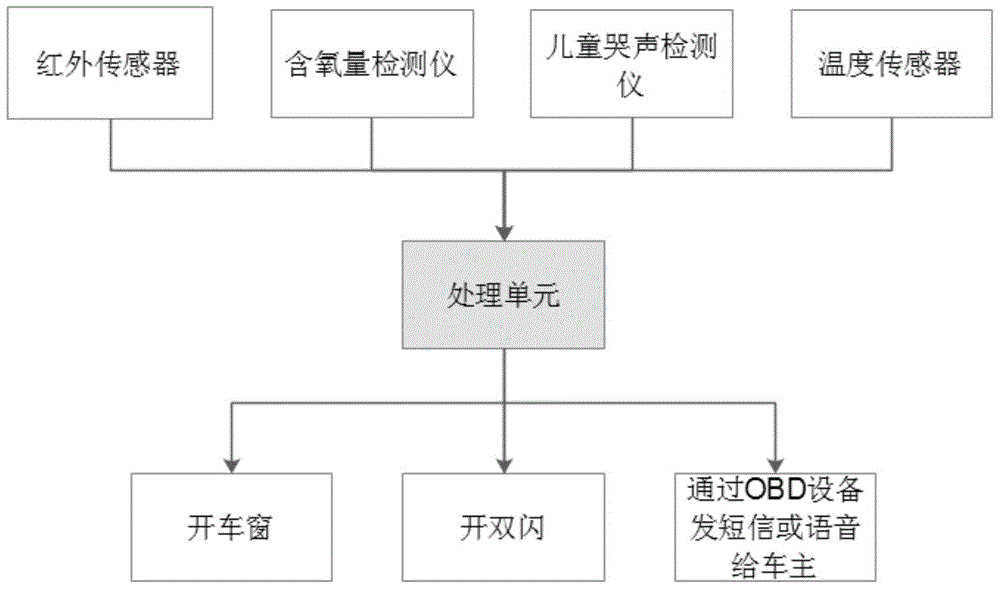Vehicle-mounted system for automatic safety processing of children left in car and processing method thereof
A safety treatment and vehicle-mounted system technology, which is applied to the vehicle-mounted system and treatment field of automatic safety treatment for children left behind in the car, which can solve the problems of air quality degradation, suffocation, insufficient oxygen content, etc., and achieve the effect of avoiding accidents and ensuring safety
- Summary
- Abstract
- Description
- Claims
- Application Information
AI Technical Summary
Problems solved by technology
Method used
Image
Examples
Embodiment 1
[0015] A vehicle-mounted system for automatic and safe treatment of children left behind in a vehicle, including a sensor array and a vehicle-mounted OBD device, the sensor array includes an infrared sensor, an oxygen content detector, a child crying detector, and a temperature sensor; the infrared sensor has the highest monitoring Priority, the oxygen content detector, the child cry detector, and the temperature sensor have the same level of monitoring priority. Only when the infrared sensor detects that there are people in the car, the oxygen content detector and the child cry detector will be activated synchronously. instrument, temperature sensor; the OBD device is used to trigger an emergency safety response mechanism.
[0016] More specifically, when the vehicle is turned off and the infrared sensor detects that there are people in the vehicle, if at the same time it is detected that the oxygen content in the vehicle exceeds the safe value, the cry of a child is detected,...
Embodiment 2
[0019] A method for automatic safety treatment of children left behind in the car. When the vehicle is turned off, the automatic safety treatment in-vehicle system of children left behind starts to work, and its sensor array monitors in real time, and transmits the real-time monitoring data to the processing center; the processing center analyzes the situation in the car And make correct and effective responses in a timely manner;
[0020] The infrared sensor has the highest priority. At this time, if the infrared sensor detects someone in the car when the car is turned off, the information detected by other sensors will be valid. That is to say, when the infrared sensor determines that there is no one in the car based on the detection information, the signals detected by the other three sensors, including the oxygen level detector, cry detector and temperature sensor, will be analyzed by the processing center for abnormalities in the car, and will not Trigger response mechani...
Embodiment 3
[0026] This embodiment also provides an in-vehicle system for automatic safety processing of children left behind in the vehicle. The system includes the following components: a sensor, a processing center, and a response action.
[0027] There are four types of sensors: infrared sensor, oxygen content detector, child crying detector, and temperature sensor; three types of response actions include opening the window, opening double flashes, and sending text messages or voice messages to the car owner through the OBD device.
[0028] The infrared sensor detects the number of people in the car. When the child cry detector detects the cry of a child, it is triggered. The oxygen content detector detects the oxygen content in the car, and the temperature sensor detects the temperature in the car. The OBD device has a mobile phone communication function.
[0029] Once a child is left behind in the car, the child will cry just before the danger occurs. The infrared sensor in the car ...
PUM
 Login to View More
Login to View More Abstract
Description
Claims
Application Information
 Login to View More
Login to View More - R&D
- Intellectual Property
- Life Sciences
- Materials
- Tech Scout
- Unparalleled Data Quality
- Higher Quality Content
- 60% Fewer Hallucinations
Browse by: Latest US Patents, China's latest patents, Technical Efficacy Thesaurus, Application Domain, Technology Topic, Popular Technical Reports.
© 2025 PatSnap. All rights reserved.Legal|Privacy policy|Modern Slavery Act Transparency Statement|Sitemap|About US| Contact US: help@patsnap.com

